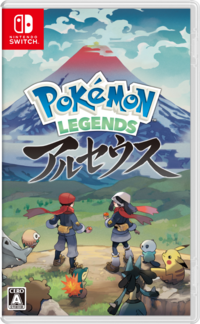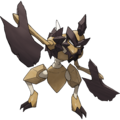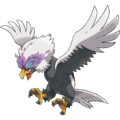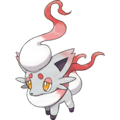Pokémon Legends: Arceus: Difference between revisions
m (Other sources have confirmed it is catch-'em-all completionism. Not Sinnohan see-'em-all, unfortunately, but not absolute 100% everything, thankfully.) |
No edit summary |
||
| Line 152: | Line 152: | ||
* This is the first core series game to not have a [[game mascot]] appear on its boxart, as well as the first to not have at least one alternate version. | * This is the first core series game to not have a [[game mascot]] appear on its boxart, as well as the first to not have at least one alternate version. | ||
* This is the first game to use Pikachu's old cry since {{g|Black 2 and White 2|s}}, and the first to use Eevee's old cry since {{g|Ultra Sun and Ultra Moon|s}}. | * This is the first game to use Pikachu's old cry since {{g|Black 2 and White 2|s}}, and the first to use Eevee's old cry since {{g|Ultra Sun and Ultra Moon|s}}. | ||
* This is the first core series game to not feature [[link battle]]s. | |||
==In other languages== | ==In other languages== | ||
Revision as of 22:16, 1 February 2022
| Pokémon Legends: Arceus Pokémon LEGENDS アルセウス | |
|---|---|
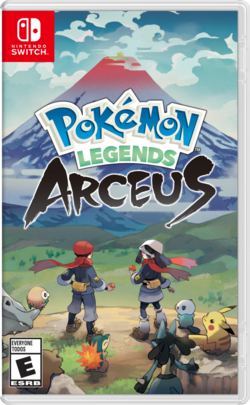 Pokémon Legends: Arceus boxart | |
Basic info
| |
| Platform: | Nintendo Switch |
| Category: | Action RPG |
| Players: | 1 |
| Connectivity: | N/A |
| Developer: | Game Freak |
| Publisher: | Nintendo/The Pokémon Company |
| Part of: | Generation VIII core series |
Ratings
| |
| CERO: | N/A |
| ESRB: | E |
| ACB: | PG |
| OFLC: | N/A |
| PEGI: | 7 |
| GRAC: | N/A |
| GSRR: | N/A |
Release dates
| |
| Japan: | January 28, 2022 |
| North America: | January 28, 2022 |
| Australia: | January 28, 2022 |
| Europe: | January 28, 2022 |
| South Korea: | January 28, 2022 |
| Hong Kong: | January 28, 2022 |
| Taiwan: | January 28, 2022 |
Websites
| |
| Japanese: | Pokémon.co.jp |
| English: | Official site Pokémon.com Nintendo.com |
|
Japanese boxart
| |
Pokémon Legends: Arceus (Japanese: Pokémon LEGENDS アルセウス Pokémon LEGENDS Arceus) is the fifth Generation VIII core series game.
The game was announced worldwide on the 25th Anniversary of the release of Pokémon Red and Green on February 27, 2021 at 12 am JST through Pokémon Presents. It was released on the Nintendo Switch worldwide on January 28, 2022. All copies of the game are playable in nine languages: Japanese, English, German, Spanish, French, Italian, Korean, and Simplified and Traditional Chinese.
Plot
The player character is transported back in time to the Hisui region by Arceus, who bestows upon them a device called the Arc Phone and the task of "seeking out all Pokémon". Upon waking up, the player meets Professor Laventon, a Pokémon Professor working for the Galaxy Expedition Team, who tells the player that they fell out of the mysterious space-time rift in the sky above Mount Coronet. After helping Laventon catch his three runaway starter Pokémon, they are escorted to Jubilife Village, where they meet Rei/Akari, the Professor's assistant and a member of the Galaxy Team Survey Corps. Since the player has no place to stay in, the Survey Corps Captain Cyllene accepts Professor Laventon's request to let them join the organization, offering them a place to stay in and food in exchange for working for them if they pass a trial set up for them. To help them pass the trial, Laventon gives the player one of the starter Pokémon they caught earlier. After passing the trial of catching a Bidoof, a Starly, and a Shinx, the player is formally accepted into the Survey Corps and given the mission of completing the Pokédex.
While exploring Hisui, the player learns that a mysterious lightning striking down from the same space-time rift they fell out is causing the Noble Pokémon around the region to on wild frenzies and attack people. The player is given the mission to visit each of these Noble Pokémon, each of which are overseen by a Warden belonging to one of Hisui region's two clans: the Diamond Clan led by Adaman, and the Pearl Clan led by Irida. Each of these clans worships a deity they refer to as the "almighty Sinnoh", but they disagree upon the other clan's viewpoint whether this deity represents time or space. During their travels, the player also has several encounters with merchant Volo from the Ginkgo Guild, who likes studying the history of Hisui, and the bandit trio known as the Miss Fortune sisters. Whenever the player defeats a Noble Pokémon or befriends a rideable Pokémon, they are gifted with a Plate.
After the player has managed to quell the last of the five Noble Pokémon, the space-time rift in the sky suddenly expands even further and the sky above Hisui turns red. Suspecting that the player, who fell out of the same rift, is somehow connected to this, Galaxy Team Commander Kamado banishes them from Jubilife Village. The player seeks help from both clans, but they refuse to help in order to maintain neutrality with the Galaxy Team. Volo, however, agrees to help the player and takes them to the Gingko Guild's secret settlement, the Ancient Retreat, where they learn that an artifact known as the Red Chain could help bind the world back together and make the rift disappear. To find the necessary materials to create the chain, the player visits each of Hisui's three lakes and receives a necessary material from each of the lake guardians. Once all the materials have been gathered, the lake guardians combine them together to form the Red Chain. With the Red Chain on their possession, the player returns to Jubilife Village, only to learn that Kamado has led the Galaxy Team Security Corps to the Temple of Sinnoh atop Mount Coronet to deal with a Pokémon sighted at the space-time rift. The player climbs to the summit and defeats Kamado in battle, finally making him see reason and apologize for doubting them.
Depending on whether the player went to look for the Red Chain materials with Adaman or Irida, either Dialga or Palkia appears at the temple. However, when the player tries to use the Red Chain on it, the artifact is broken to pieces, forcing the player to confront the Legendary Pokémon. Although the player manages to catch it, the other Legendary Pokémon then appears as well, forcing everyone to retreat. Using a clue given by the Legendary Pokémon the player caught, Laventon crafts the Origin Ball, a one-of-a-kind Poké Ball created out of the Red Chain fragments and a sample of the Origin Ore, which they decide to use to stop the Legendary Pokémon at Mount Coronet. The player returns to the Temple of Sinnoh, where the Legendary Pokémon transforms into its Origin Forme, destroying the temple in the process, before challenging the player and its counterpart. After defeating it, the player uses the Origin Ball to catch the Legendary Pokémon, causing the space-time rift to disappear and returning the sky back to normal. With the appearance of both Dialga and Palkia, the Diamond and Pearl Clans realize neither of them was worshipping a false deity and set aside their differences.
After a feast to celebrate the player's success, Volo asks them to investigate the Plates and collect the ones they don't own yet. The player travels around Hisui and collects Plates from various sources, most commonly receiving them from the Legendary Pokémon of Hisui. Once the player has collected 17 of the 18 Plates, Volo tells them of Giratina, a Legendary Pokémon just as powerful as Dialga and Palkia, which was banished to another world due to its cruelty. He takes the player to the ruins of the Temple of Sinnoh, where he reveals that he was the one who caused the space-time rift to appear by seeking out Giratina, in the hopes that Dialga and Palkia's appearance would make Arceus appear and allow him to use its power to create a new world. He challenges the player to a battle, but once he's defeated, Giratina appears by his side and challenges the player, transforming into its own Origin Forme midway through the battle. Once Giratina is defeated, Volo hands the player the final Plate, at which point the player's Celestica Flute transforms into the Azure Flute. Volo is surprised by Arceus having chosen the player instead of him and leaves in anger, swearing to one day conquer Arceus and create a new world, even if it will take him centuries to do so.
Once the player has caught at least one of every Pokémon and completed the Pokédex, they return to the Temple of Sinnoh and play the Azure Flute, granting them access to the Hall of Origin, where Arceus challenges them. Once the player has emerged victorious, Arceus willingly joins them and grants them the Legend Plate, which allows the Mythical Pokémon to change its type mid-battle. The whole Galaxy Team gathers to celebrate the player's completion of the Pokédex, with Cyllene rewarding them with a Shiny Charm.
| Spoilers end here. |
|---|
Blurb
You'll be brought to the Sinnoh region, the setting for the Pokémon Diamond and Pokémon Pearl games. But this story unfolds in a long-gone era, before ideas such as being a Pokémon Trainer or having a Pokémon League even existed.
All around, you'll find Pokémon living wild in harsh environments that make for a Sinnoh unlike the region you may remember from the days of the Pokémon Diamond and Pokémon Pearl games.
Features
- The game features Rowlet, Cyndaquil, and Oshawott as starter Pokémon, and Rei and Akari as player characters. Other NPCs include the members of the Galaxy Expedition Team. The player character that is not selected appears in the story as an NPC.
- The game takes place in the Hisui region, a past version of Sinnoh.
- All standard wild encounters now appear to be symbol encounters. Pokémon may exhibit different behaviors, such as fleeing, sleeping/waking, emoting, or becoming aggressive. These behaviors may differ depending on the in-game weather or time of day.
- The player may catch Pokémon from the overworld directly by throwing a Poké Ball. An aiming reticle appears on-screen during this. Hitting a Pokémon from behind with a Poke Ball when it has not yet seen the player greatly increases the likelihood of capture.
- Poké Balls have an "old-fashioned" appearance in this game, with a wooden bottom half, a buckle-shaped metal-colored implement instead of a button, and a valve on top that puffs out steam on a successful catch.
- To battle a wild Pokémon, the player must throw one of their own Pokémon's Poké Balls nearby. Hitting the wild Pokémon with the ball while it is unaware of the player will surprise it, causing it to skip their first turn.
- In the overworld, the player has access to action-related elements such as rolling and diving leaps.
- A feature similar to Ride Pokémon appears to be present, with Hisuian Braviary shown representing flying/soaring, Basculegion shown representing surfing, and Wyrdeer shown representing fast overworld movement.
- Some unique actions are shown during this, such as having Hisuian Braviary change its flight pitch angle, Basculegion leaping over an land obstruction in the water and down a waterfall, and Wyrdeer jumping.
- Particularly strong Pokémon with angry red eyes, known as Alpha Pokémon, can be found in the overworld and in battle. These Pokémon may be caught, but are far stronger than others of their species and may possess moves they might not be able to learn normally.
- Noble Pokémon, Pokémon sacred to the people of Hisui that have become frenzied through unknown causes, act as boss battles. To defeat a Noble Pokémon, players must throw special Balms to calm it down while avoiding its attacks. Occasionally, the Noble Pokémon will drop its guard and allow the player to engage it in a Pokémon battle; upon reducing its HP to 0, the Noble Pokémon will be temporarily stunned, making Balms more effective and allowing the player to throw them without any risk of being attacked.
- Pokémon may attack the player in the overworld, and the player may also take damage by falling from high places. Taking too much damage will cause a black out.
- A feature visually similar to Pokémon Camp can be seen, with six party Pokémon surrounding the player in an overworld setting.
- The concept of turns in battle has received an overhaul, with the game now presenting an Action Order showing which sides are to get the next six turns. Depending on speed and "other factors", one side may get multiple turns in a row.
- Moves can be "mastered" by leveling up. A mastered move may be used in the strong style, which increases that move's power but lowers action speed, or in the agile style, which decreases that move's power but raises action speed. Both styles increase the PP usage of the move when they are used.
- Outside of Jubilife Village, Pokémon Centers appear to have been replaced by base camps, which allow healing, item purchasing, and the new item crafting feature.
- The player's Bag is now referred to as a "satchel".
- Completing a Pokédex entry now requires more than just catching a certain Pokémon once, with other requirements varying from multiple catches to seeing a Pokémon use certain moves multiple times.
- The player receives a device called the Arc Phone early in the story, whose design distinctly resembles Arceus. In one screenshot, it is seen displaying an area map as well as the player's current goal.
- Like in Pokémon: Let's Go, Pikachu! and Let's Go, Eevee!, EVs have been replaced by Ganbaru Values.
- The Freeze and Asleep status conditions have been removed; they are replaced by the new status conditions Frostbite and Drowsy.
- Entry hazards no longer exist. Former entry hazard moves such as Stealth Rock now cause direct damage along with further damage over later turns, similar to moves like Fire Spin.
New Pokémon and forms
- Seven new Pokémon (Kleavor, Wyrdeer, Ursaluna, Sneasler, Overqwil, Basculegion, and Enamorus) have been added, from which the three first evolve from already discovered Pokémon (Scyther, Stantler, and Ursaring respectively) and the three next from new forms of already discovered Pokémon (Sneasel, Qwilfish, and Basculin respectively).
- Sixteen new Hisuians (Growlithe, Arcanine, Voltorb, Electrode, Typhlosion, Sneasel, Qwilfish, Samurott, Lilligant, Zorua, Zoroark, Braviary, Avalugg, Sliggoo, Goodra, and Decidueye), one new regular form (white-striped Basculin) and two new Origin forms (Dialga and Palkia) have been added.
Connectivity
The game is confirmed to support online connectivity and trading with other players, but will not support Ranked Battles. The game is planned to receive Pokémon HOME connectivity at some point in 2022.
Staff
- Main article: Staff of Pokémon Legends: Arceus
Version history
| Version | Release date | Game File Size | Official note | More information |
|---|---|---|---|---|
| 1.0.0 | Original release | 6.0 GB | N/A | Initial release. This version is officially playable using a physical Game Card in a Switch whose internet connection remains off. |
| 1.0.1 | January 26, 2022 | 6.0 GB | Fixed some problems for a better gaming experience. |
Gallery
Logos
Characters
The male player character, Rei
The female player character, Akari
Commander Kamado
Captain Cyllene
Adaman, leader of the Diamond Clan
Irida, leader of the Pearl Clan
Warden Mai
Warden Lian
Warden Iscan
Warden Arezu
Merchant Volo
Merchant Ginter
New Pokémon
Trivia
- Despite its title not containing the full name of "Pocket Monsters" in Japanese, Pokémon Legends: Arceus is considered to be a part of the core series by the official website.[1]
- It is also the only core series game not to contain the full name of "Pocket Monsters" in that language.
- This is the first solitary core series game since Platinum, which also takes place in Sinnoh.
- This is the first core series game to not have a game mascot appear on its boxart, as well as the first to not have at least one alternate version.
- This is the first game to use Pikachu's old cry since Pokémon Black 2 and White 2, and the first to use Eevee's old cry since Pokémon Ultra Sun and Ultra Moon.
- This is the first core series game to not feature link battles.
In other languages
| |||||||||||||||||||||||||||||
References

|
This game-related article is part of Project Games, a Bulbapedia project that aims to write comprehensive articles on the Pokémon games. |
